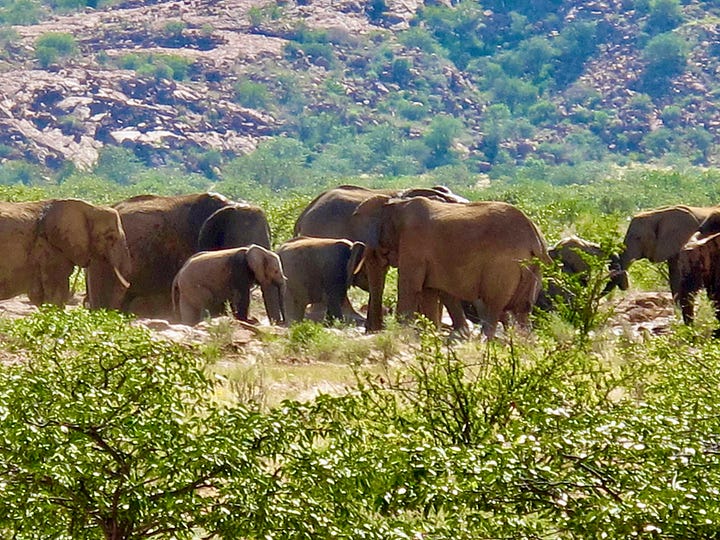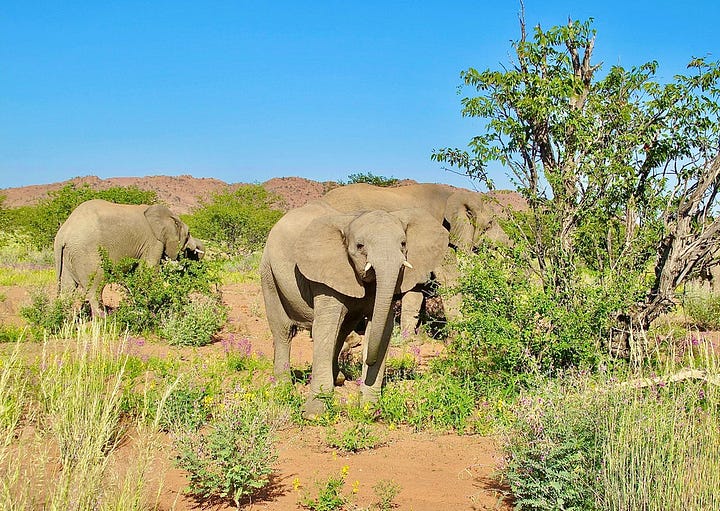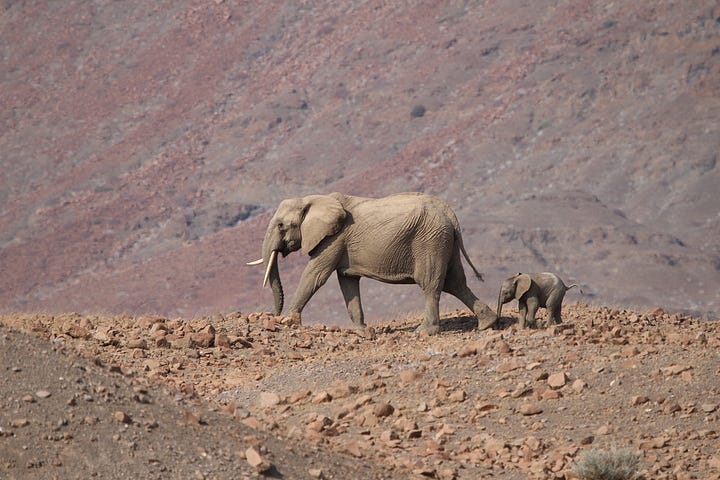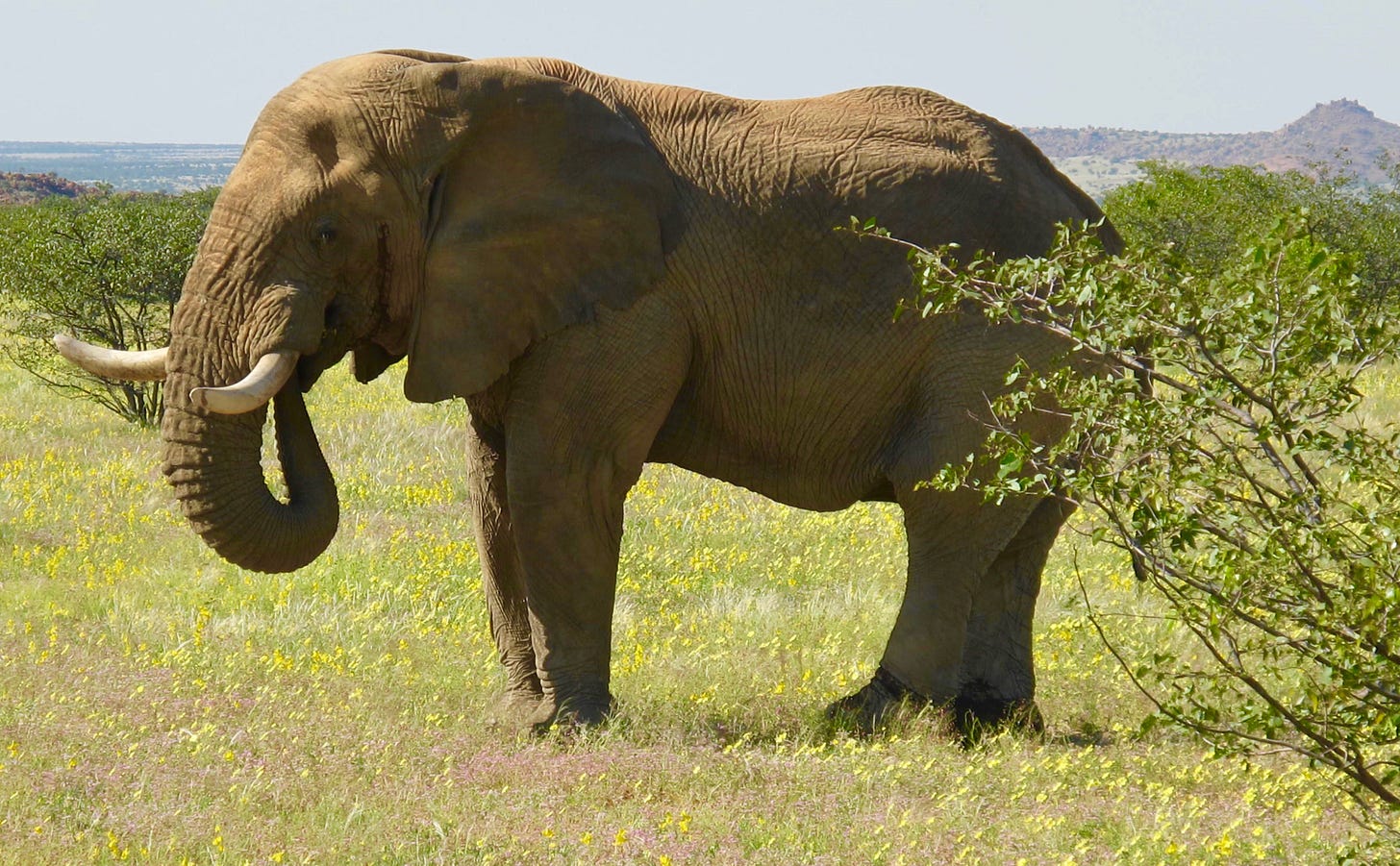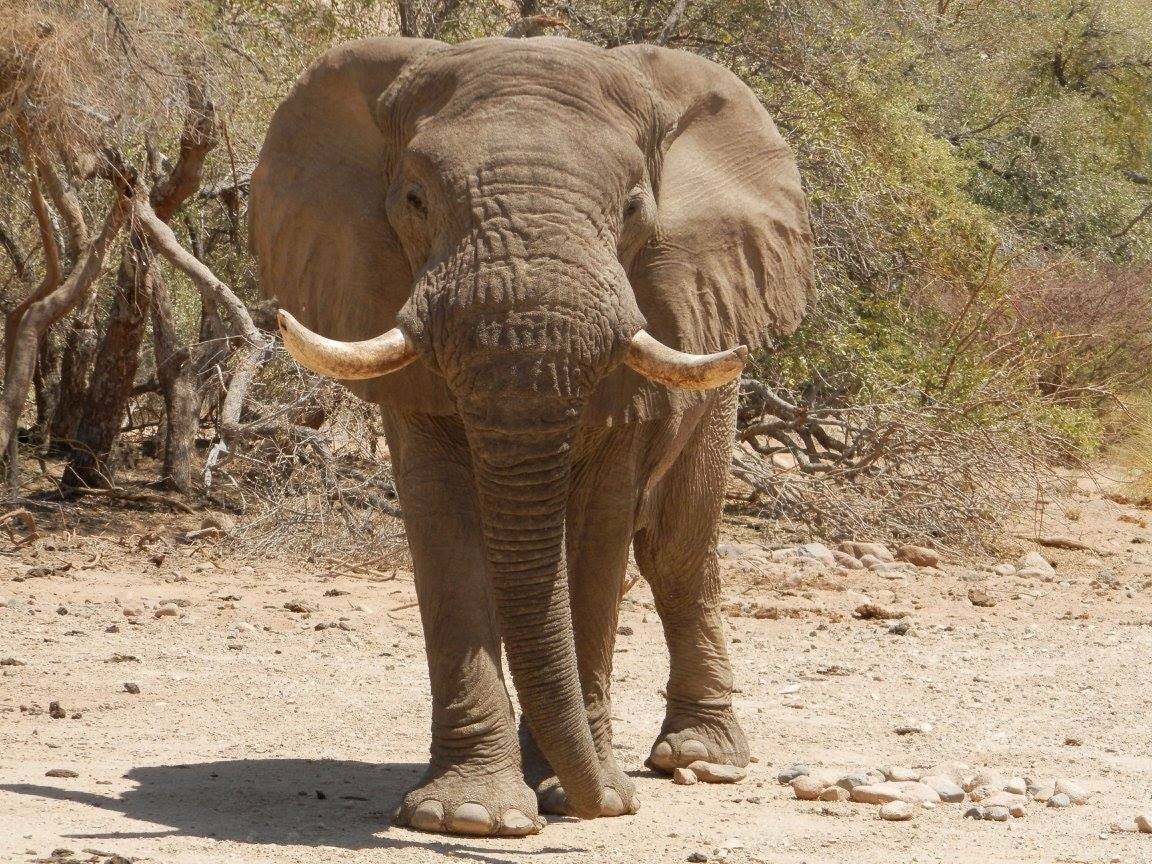
When I met him, he was eating flowers.
The spring rains had drawn yellow blossoms out of Namibia’s arid, red-ochre ground. The flowers swept in a lemony haze towards the horizon, where the purple massif of Mount Brandberg rose. Their scent, sensual as jasmine oil on sun-warmed skin, was mingled with the sweet-hay smell of the elephant’s fresh dung.
He stood alone on the saffron-coloured plain, feeding on the flowers and the silvery grasses. From the jeep I watched him extend his trunk in slow serpentine coils along the ground; curl the tip around bunches of grasses, stems and flowers and neatly tap away the dust against one tusk before tucking them into his mouth.
We’d parked the jeep at some distance, being careful to show him that we respected his space. He clearly understood the signal: he glanced briefly at us, his amber gaze thoughtful, assessing, then he carried on calmly eating, keeping the same tranquil, unhurried rhythm, plucking, tapping, chewing.
It’s Voortrekker, my friend Jill whispered. He’s the elder male here, we call him The Old Man. He’s such a cool bull. Her hands on the steering wheel, she fell silent, looking at Voortrekker, and smiling gently to herself from time to time.
Male elephants become bigger as they age. Their faces and their bodies show the lines of their life experience, just as ours do. Voortrekker had the majestic presence of the mature male elephant - very broad across the shoulders and chest, with ribs hooped wide about his ample belly, and padded feet sprung beneath the weight of his bones.
Draping his heavy trunk in a casual fashion across one tusk to rest the weight, he sauntered over to a patch of bare ground. He stirred up the surface with one foot, scooped up a trunkful of sand and tossed it up over his shoulders and head. The red dust ignited around him in the sunlight; he turned to face our jeep and I saw for the first time the entire breadth of his extraordinary face: his forehead streaked with the rust-iron red of the ground, his tusks splayed on each side of his upper trunk.
His ears fanned back and forth, a regular slow pulsation that was like the visible beating of his heart. My breathing expanded; my own heart-beat slowed: here, I knew, was a remarkable individual - a person in elephant form, somebody with long life experience, who was carrying the wisdom of his kind.
I could have sat with him for hours, feeling the waves of calm authority he emanated. But after some time, he stepped away from the jeep and moved behind some bushes. The message he sent us was clear: our audience for the day was over. And Jill understood his meaning; she re-started the jeep and we left Voortrekker to his peace.
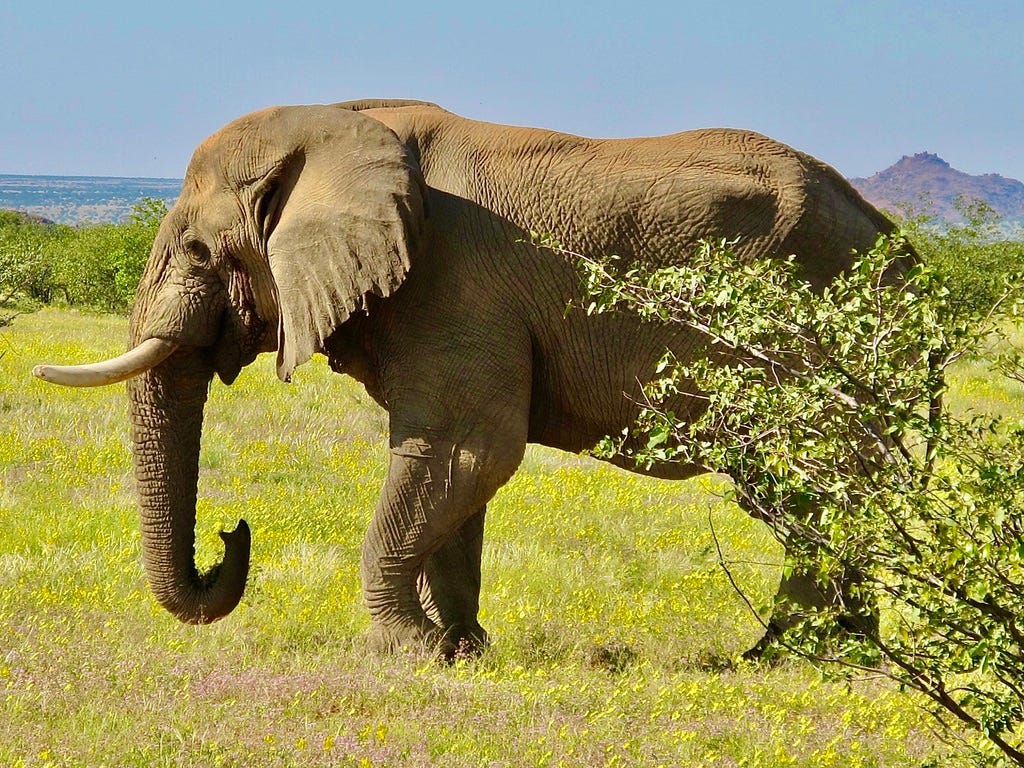
We spoke about Voortrekker that night by our campfire, beneath the great arch of the galaxy that spans the Namibian night. His name came from the Afrikaans word meaning the pathfinder, or the one who shows the way and itwas inspired by the series of epic journeys he had made through some of Northern Namibia’s harshest stretches.
The desert elephant communites of Damaraland in Namibia are one of only two in Africa; the others live at the edge of the Sahara, in Mali. Desert elephants have a deep understanding of the ecology of these arid habitats and they hold the memories of their short and long-term climate cycles. The elders, both female and male, are the keepers of these memories and the knowledge of how to survive, how to find water sources and food, in such dry places. They teach this knowledge to their young, a process that biologists now recognise as cultural transmission, not only among elephants but within many wild animal communities. Cultural knowledge is passed on, from one generation to the next, between elder and younger, within families and communities.
During Namibia’s war for independence from South Africa in the 1980s, this cultural continuity was damaged. Many desert elephants were slaughtered for food by desperate farmers or poached for their ivory.
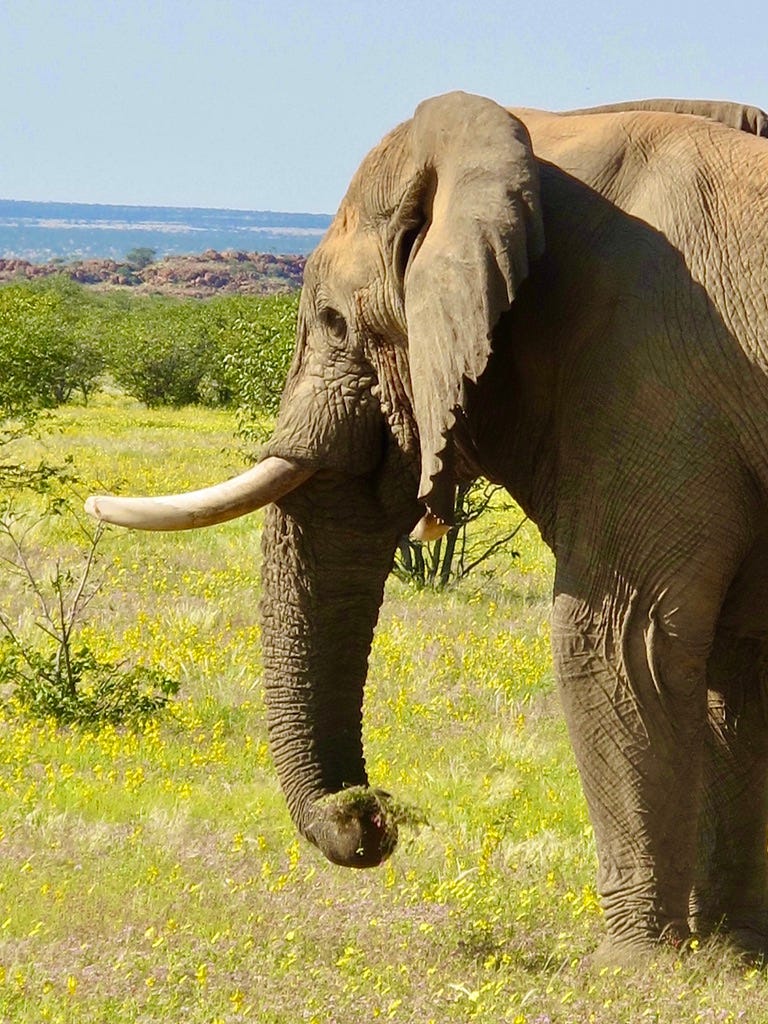
Others fled in terror at the violence, and sought refuge further north, by the Angolan border with Namibia.
The dry Huab and Ugab valleys of Northern Damaraland had been empty of elephants for decades when Voortrekker appeared in the late 1990s. He had come from the north, crossing bare gravel plains and dunes where his steps sank deep in sand. He had traversed the high crater of an extinct volcano, a barren place without food or water for him, where the ancient plants known as weltwitschia slowly grow for a thousand years or more among the rocks.
When he reached the relative bounty of the river valleys, Voortrekker spent several weeks carefully exploring their resources. He used his feet to dig for the water he sensed and smelt beneath the sand and he fed on the Commifora bushes, and the nutritious leaves of the Ana trees that grew along their banks.
Then he disappeared.
Months later he returned. This time he was not alone. A small family of females and young had come with him, across the volcanic crater and the gravel plains.
“It was a marathon across arid plains and ancient craters that would ultimately redefine what we know of elephant endurance, intuition and behavior.” said Alan Macsmith, one of my guides, a teacher of elephant communication, with thirty years of experience among them in the wild. “Just how he navigated and found water is anyone’s guess.”
The following year Voortrekker repeated the journey; once again he returned with a small family group. These elephants, and their descendents are still present in Northern Damaraland today.
Voortrekker, though, is not.
Early one morning in June 2019, I got a text from Alan.
Vootrekker is dead, Alan wrote; shot by a trophy hunter. And the world is changed.
The truth is, I wept when I got Alan’s text. I could still see him, poised among the fragrant yellow flowers and the rough pyramids of red rock known as kopjes. I remembered his mild, attentive gaze on us, the peaceful way he bore his imposing, physical power.
I thought then - and I still think now - that Voortrekker had allowed us to find him in that luminous setting. He could have easily avoided our jeep when he heard it coming from a distance. Yet he remained, calmly maintaining the cadence of his day and wordlessly sharing something of the depth of who he really was: the inner presence concealed within his cloak of creased grey hide and the massive scaffolding of his bones.
Like all elephants, Voortrekker kept the land alive. His foot-falls carried its renewal. The fragrant oils of the flowers on which he fed had been nourished by his dung: termites pulled down the part-digested strips of bark and leaves his dung contained and fed them to the fungus they nurtured in the gardens they maintained beneath their towers. At night, dung-beetles rolled away the seeds he scattered and buried them, their paths guided by the touch of starlight on their backs. The places where he dug for the water beneath the dry river beds that run across the Namib desert became the wells where other birds and animals came to drink.
Where he walked the land rose resinous, camphor-scented, humming with the transferences of energy and materials that maintain the vital processes of life.
Biologists use the term “keystone species” to describe how elephants and other powerful animal architects maintain the structures of the living world, the biosphere. Without their presence and their activity, without their ecological knowledge and their long-term memories of climatic cycles. living structures lose their integrity and wholeness. They begin to crumble. The pattern frays; the green brilliance fades; the vitality ebbs away. Without the stabilising effects of wild animal activity, the climate itself becomes severely unbalanced.
The importance of wild animal communites to the integrity of the biosphere and the stability of the climate is slowly becoming evident to science.
But we humans need to realise that these processes of renewal are not impersonal. That they emerge through the lives of beings who love and grieve just as we do, who are ready to face danger and walk in uncertainty - as Voortrekker did - to ensure a future for their children.
The elephants - and the other wild animal beings I write about here - know who they are. They know that they participate in the weaving of the living world: this awareness is inherent in their dignity, in their capacious memories, in their sureness of perception and their composure. And so this Substack is dedicated to Voortrekker, and to all those forgotten ones, who quietly weave the natural world that sustains us - the furred and the finned, the winged and feathered, and those who travel the oceans, clothed in blubber, bone and flesh.
